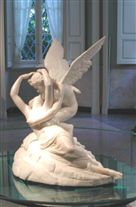4d417935318d0.jpg
Eros and Psyche's Room - Click 'Details' for more information
EROS AND PSYCHE'S ROOM:
In the centre of the room it's possible to admire the marble group Eros and Psyche reclining by Antonio Tadolini, one of the best Canova's scholars. It's a replica taken from the original model of Antonio Canova of the sculpture commissioned by the Russian prince Yussupoff (today at the Hermitage museum in St. Petersburg). Made from a block of Carrara marble of exceptional beauty, this sculpture arrived in Tremezzo in 1834 where it became a real icon of sensuality and passion. Near the wall, on two precious pedestal in Varenna marble are located the busts of Venus and Paris by Pietro Fontana (1757-1822), inspired by the famous canovian models. In a showcase is exhibited a biscuit representing a Triton with a Nymph; above it, a bas-relief medal with the portrait of Napoleon during his Italian campaign, made in 1798, by Francesco Lazzarini (?-1808): it's one of the very rare work of this sculptor and it well represents the Sommariva's cult for Bonaparte.
The apotheosis of Napoleon the Emperor is the subject of the frescoes of Andrea Appiani (1754-1817) hanging from the ceiling and the wall: they are the sole evidence - survived the bombing of 1943 - of the large decorative cycle done by Appiani for the Royal Palace in Milan in 1808. In the great octagonal medallion, Napoleon is portrayed on a imposing throne, supported by four winged victories and surrounded by the Zodiac and the Hours. In the four lunettes are represented the cardinal virtues: Prudence with mirror, sand-glass and sphinx, Justice with sceptre and Law code, Fortitude with lion, shield and club and Temperance with a winged genius mixing water and wine. In this room is also located a precious neoclassical chest of drawers in inlaid walnut, varnished and gilded, produced around 1776 by Giuseppe Maria Bonzanigo (1744-1870), based on the drawing by Piacenza and Rondoni and originally in the Royal Palace in Milan.
